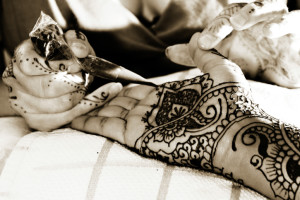
A flowering plant native to northern Africa, the Middle East and India, Henna has been cultivated since ancient times. A dye is produced from its leaves that can be used for temporary tattoos and to color fabrics. In parts of Africa, and other eastern countries including Saudi Arabia, Pakistan and India, it is customary for brides to be decorated with henna designs, also called mehndi, before their weddings.
Cultivation
Henna plants are actually shrubs. The quality and quantity of dye they produce is highly variable based on growing conditions; regions of the world that have semi-arid or tropical climates are ideal for raising henna.
- 95 to 113 degrees Fahrenheit is the optimal temperature range for growing henna.
- If the temperature is below 52 degrees Fahrenheit, the plants are dramatically less productive.
- Henna plants will die if exposed to temperatures below 41 degrees Fahrenheit.
Production
In order to transform henna into dye, the leaves must be dried and are then crushed into powder. The powder is mixed with different liquids, such as water, orange or lemon juices, vinegar and tea to form a dye paste. Molasses and sugar are frequently blended in to improve consistency and help tattoos better adhere to the skin. The mixture is then set aside for anywhere from 1 to 48 hours, depending on the type of henna, to increase the effectiveness of the dye. Incorporating lavender and cajeput oils into the paste is also known to make the stain more intense.
Hair Dye
Henna-based hair dye has been in existence for 6,000 years. The ancient Egyptians used it and so did 19th century English ladies. Comedic icon Lucille Ball brought it to the attention of American women when she colored her hair with it on “I Love Lucy.” Muslim men use it today to dye their beards. The final hair color varies based on the type of henna and original shade of the hair. The results typically range from burgundy on the dark end of the spectrum to orange on the light side.
Body Art
Henna has been used for thousands of years to decorate women’s bodies. The application was a common ritual for important holidays and other social occasions. Night of the Henna is a celebration that took place before weddings and involved the bride and groom being adorned with temporary henna designs. It still takes place today and is most popular among Hindus, Muslims and Jews who often reside in countries where the plants are indigenous. Henna body art is becoming more common in the United States and Canada as a result of the influx of immigrants. Mexican and Caribbean tourists may also have the opportunity to get temporary henna tattoos while on vacation.
Health Concerns
The application of henna to the body may create health problems for some people. Individuals with G6PD deficiencies (a type of genetic disorder) can have severe reactions if it touches their skin, and men are much more likely to be afflicted with this condition than women.
The Food and Drug Administration (FDA) has not approved the dye for use on the skin. It can still be imported into the United States if it is labeled as hair dye. Any henna products that appear destined for use on the skin may be seized.
Black henna can be dangerous when used for body art, and contains other ingredients such as indigo and various chemical compounds. This type of dye is desirable by some because it stains quickly, but if left on the skin for over two days, it may leave permanent scars. Severe allergic reactions that result in intense itching and blisters are another potential problem.
For millennia, henna has played a role in the cultural practices of countless civilizations. The dye produced from its leaves has been used to adorn innumerable brides, color the hair of Lucille Ball and decorate everyday women.

